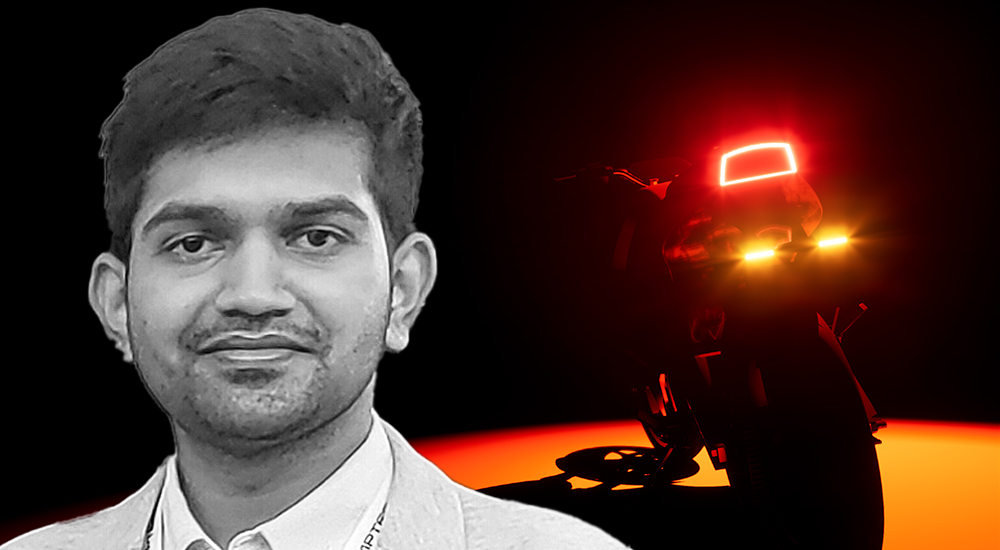Raptee Energy is leveraging cloud and AI in its intelligent, electric motorcycles

Raptee Energy is an e-mobility start-up working on. Raptee is building the first-ever high voltage, software driven electric motorcycle that will supersede its petrol-powered counterpart in terms of performance, reliability, comfort and most of all cost of ownership.
“Commuters of the modern-day need more than just a vehicle that runs on electricity that replaces fuel consumption. We see e-motorcycles not as a direct replacement of fuel engine vehicles but as an evolution towards a better commuting experience,” says Dinesh Arjun, Co-Founder and CEO, Raptee Energy.
Raptee has built a power unit that will help deliver performance of a high-powered motorcycle.
Raptee has built a power unit that will help deliver the performance of a high-powered motorcycle, with a top speed of 135 kmph and a range of 150 km per charge.
Raptee is building the first-ever high voltage-based software electric motorcycle that operates on a patented 240V drivetrain, in contrast to the 48V systems that are prevalent in the current EV industry.
One of the biggest barriers for adoption of electric motorcycles around the world is the charging infrastructure. Raptee motorcycles use the Combined Charging System CCS2 standard for charging, which is the most widely used standard of charging globally.
“This makes us the first and only electric motorcycle to be able to leverage existing public charging infrastructure that is already in place for other electric four-wheelers,” says Arjun.
Raptee motorcycles come with an on-board charger. This means that unlike most of the other electric vehicles in the current market that require an external accessory for charging in different ports, Raptee’s electric two-wheelers directly support both AC charging and DC fast charging, at home and in public infrastructure. The vehicle charges up to 80% in 25 minutes in DC fast charging.
The maintenance costs of Raptee electric motorcycles are significantly less than that of internal combustion engine motorcycles. This is achieved through predictive maintenance. With Raptee electric two-wheelers, the user will be spending 95% less on maintenance costs and will be looking at only INR 0.2 per km as fuel cost.
Raptee is building the first ever high voltage-based software electric motorcycle that operates on a patented 240V drivetrain.
80% of all issues will be diagnosed remotely and 70% of them resolved remotely. Most of the maintenance issues that exist with internal combustion engine motorcycles will be a thing of the past. However, brake pads will be a part of the regular maintenance for electric vehicles, but the wear and tear will be reduced due to regenerative braking.
According to Wikipedia, regenerative braking is an energy recovery mechanism that slows down a moving vehicle by converting its kinetic energy into a form that can be used immediately or stored until needed. The electric traction motor uses the vehicle’s momentum to recover energy that would otherwise be lost at the brake discs as heat. In addition to improving the overall efficiency of the vehicle, regeneration can significantly extend the life of the braking system as the mechanical parts will not wear out very quickly.
One of the biggest barriers for adoption of electric motorcycles around the world is the charging infrastructure.
“We understand the importance of longevity which is why our vehicle is designed to last as long as internal combustion engine motorcycles,” adds Arjun. Raptee vehicles will come with a powertrain warranty of 8 years ensuring longevity of the vehicle.
Intelligent electric motorcycles
There are multiple factors that make Raptee electric vehicles intelligent. Raptee has implemented first-of-its-kind features in its motorcycles. Raptee has built its IP in battery management system, pack assembly, vehicle control unit, chassis, motor controller, HV circuitry, safety systems and other sub-components inside the vehicle.
Raptee has developed its battery management system, which will make sure all the cells are protected from aggressive usage, fast charging and discharging and ensure all the cells are charged efficiently through active balancing.
“With our machine learning algorithms, the user will get maximum output from the vehicle,” says Arjun.
The vehicle control unit predicts energy consumption based on in-built artificial intelligence and constantly works on minimising energy consumption. Using throttle mapping control algorithms, different drive modes are obtained to achieve peak performance in the vehicle. The vehicle control unit understands riding patterns, reduces power consumption, alerts you when any service is due, alerts you of any imminent crash, and increases the life of the vehicle.
The vehicle control unit collects real-time data from the vehicle and sends it to FOSSIL. FOSSIL is Raptee’s advanced telemetry and vehicle data analytics platform based on real-time artificial intelligence. This is cloud-native and collects information like telemetry data, trip data, fault codes from the entire fleet of vehicles. It correlates the collected data and provides meaningful insights It also runs analysis on real-time data to find out the anomalies in the vehicle to notify the rider and the manufacturer about any imminent failure.
FOSSIL collects data from all the electric motorcycles connected to the network and constantly updates the algorithm to improve the performance of the vehicles. Data collected is protected by authentication in each step of the system. This means any critical issues in any of the vehicles in the fleet can be rectified and corrected remotely through over the air updates. The user will also be updated with the latest information about the vehicle through in-house applications.
Raptee motorcycles use the Combined Charging System, CCS2 standard for charging, which is the most widely used standard of charging globally.
The entire system is built using Amazon Web Services as a backend and proprietary frontend dashboard.
“With our proprietary hardware and software features, we are looking at a high-performance motorcycle with advanced safety features, trouble free charging and maintenance that is constantly evolving,” says Arjun.
Investment models and expansion
“This is a very capital-intensive area, and we will require large amounts of capital to put a worthy product on the road. However, being a start-up without any constraints to abide by, we are able to avoid a lot of redundant processes that legacy manufacturers have to take care of. This also gives us the freedom to explore alternative methods of design, tooling and manufacturing processes,” explains Arjun.
Raptee has raised close to $1 Million so far through investments, grants and prize money. This has helped to get its technology validated and prototypes on the road for testing. Raptee is looking at raising $11 Million which will be spent on testing, tooling and manufacture of the first batch of motorcycles that will hit the roads later this year.
Raptee’s electric two wheelers directly support both AC charging and DC fast charging.
India sold 21 Million two-wheeler vehicles in 2018-2019 and over 65% of these were motorcycles. Yet there is not a single motorcycle in the market that can replace the internal combustion engine counterpart. It is expected that more than 80% of all global two wheelers sold in 2030 will be electric.
Go to market challenges
Most of the electric two wheelers in the market require their own charging infrastructure based on the charging system that were developed specifically for those models. These take up a huge portion of the capital of the company. Without charging stations at adequate intervals the user will have the problem of range anxiety.
Range Anxiety is the fear of the consumer that the charge on their battery may not be enough to take them to their destination, a problem that was not considered for internal combustion engine vehicles where there was the availability of fuel stations at close distances.
Raptee electric vehicles solves both of these problems. “Since our electric vehicles follows the CCS2 standard of charging, we are able to leverage the existing charging infrastructure set up for four-wheelers in the country,” elaborates Arjun.
The vehicle charges 80% in 25 minutes in DC fast charging.
For example, there are 25 charging stations in Chennai alone, an Indian megapolis, a number that is expected to increase significantly. And with a real-time range of 150km for Raptee electric vehicles, the user will not have to worry about charge issues or any other performance issues that are commonly seen as an adoption barrier
Scaling out and road ahead
Raptee is currently in process of setting up its first factory with the production capacity of 2,000 units a month. According to Arjun, as a start-up disrupting the electric motorcycle market, communication with vendors and setting up the assembly line can be considered as obstacles in the roll out of the manufacturing plant. The $11 Million that Raptee is planning on raising, will be spent on testing, tooling and manufacture of the first batch of electric motorcycles. Raptee will be manufacturing its own battery packs.
Once the initial production capacity has been established, Raptee will begin the process of setting up a larger manufacturing plant. Raptee has signed an MoU with the Government of Tamil Nadu under which it will be investing $63 Million over an eight-year period for the development of the electric vehicle manufacturing ecosystem, employing about 3,500+ people and increasing its production capacity.
Raptee’s vision is a world where independent commuting is safe, affordable, stress-free, environmentally responsible, not limited to any country.
There are many players in the passenger car market who are working towards bringing safer and sustainable mobility, and yet a significant part of the world’s population cannot afford a car. “We see potential to revolutionise the way people commute in these countries,” points out Arjun. However, as a start-up, Raptee’s resources are limited, and it needs to focus on areas of priority.
Raptee’s global expansion is planned for late 2024, with the initial focus on the Indian market.
80% of all issues will be diagnosed remotely and 70% of them resolved remotely.
“We acknowledge that the incumbents have kicked-off their electric transition strategies and we believe that they will play a role in making electric vehicles mainstream. What we are betting on is the technology that we have pioneered,” says Arjun.
Most of the products in the market still rely on architecture similar to electric vehicles from China. “We believe our powertrain architecture, that we have developed and tested over the last two years, will pave the way for a new age of electric two-wheelers. This lead will give us the edge over existing manufacturers”, he concludes.

Raptee is building innovation into its planned electric motorcycle production with a proprietary vehicle control unit, cloud connectivity, AI and ML data loops, electric power train.




